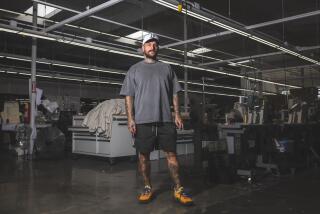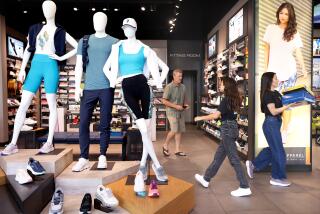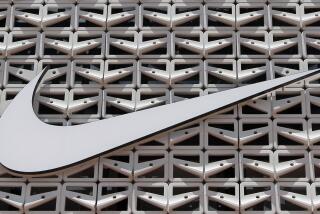Simple Sneakers Are Still In
PORTLAND, Ore. — Matt Nybo, a 13-year-old with spiked blond hair, came to the downtown Lloyd Center Mall looking for a sports shoe--but not the latest Nike Shox or Reebok Answer V.
“I like the original shoes, the way things used to be,” he said, turning up his nose at a rack of shiny new basketball shoes at a Foot Locker store. The newer shoes were too gimmicky, he said.
“The new things coming out, there’s a zipper over the laces. I like the simpler shoes,” he said.
Teenagers across the country more and more are rejecting ultramodern-looking 2002 athletic shoes in favor of what are called “old school” sneakers in the styles of the 1970s and ‘80s.
In an industry-shaking development that began with trend-setting collectors in Japan, the throwback niche now accounts for about 25% of the $5-billion global sports shoe market.
Nybo settled on an old school pair of white Nike Air Force Ones that cost $74.
Companies have brought back dozens of sneaker styles that first appeared years ago to capitalize on the demand.
Shoes such as the Nike Cortez, the Converse Weapon, Adidas’ Copenhagen or Reebok’s Aztec II hark back to sports stars of the 1970s and ‘80s and are bought for style over performance.
Some fashion watchers say the trend is a rebellion against technology or a desire to return to a seemingly simpler era in sports and culture. Price also is a factor--most of the retro shoes are priced under $100, compared with $160 for top-of-the-line shoes.
“It’s a very important trend right now,” said Eric Oberman, spokesman for the basketball shoe division at Nike Inc. The world’s largest athletic footwear maker, Nike is based in the Portland suburb of Beaverton.
Major U.S. distributor Foot Locker Inc. expanded its classic shoe rack from about one-sixth to one-half of the total display for men’s athletic shoes three months ago.
Nike rival Reebok International Ltd., based in Canton, Mass., believes that up to 30% of the U.S. athletic shoe market is in retro styles, said Steve Gardner, who directs Reebok’s classics division.
And old school is the newest thing on a much bigger scale in some markets.
Retro sales comprise 40% to 45% of the athletic shoe business in Los Angeles, New York, Miami and some countries such as Britain and Japan, Gardner said.
Industry watchers say the trend got traction in Europe and Japan. Trendsetters bought used athletic shoes over the Internet; used shoes still trade briskly on EBay.
“It’s the only business in Japan” for athletic shoes, Gardner said.
The popularity of old styles is proving serendipitous for shoemakers. In recent years, profits have been down because of slack sales of top-priced shoes such as the Nike Shox.
Robert S. Drbul, an athletic footwear analyst with Lehman Bros. in New York, said the volume of “mid-priced” shoes under $100, including most retro shoes, have buoyed sales this year.
In the retro category, design costs were taken care of years ago. Companies also haven’t invested in heavy marketing blitzes that are typical with modern shoes.
Retro shoes sell briskly with the primary market of teenage boys, but also among older buyers. Some owned the shoes the first time around, and enjoy finding clean, sweet-smelling new pairs for sale today.
“In some cases, people have an emotional attachment to when they first bought the shoe,” said Nike’s Oberman. “They say, ‘I was playing high school basketball when that shoe came out. I loved it.’ ”
Nike rolled out the Cortez in 1972, soon after founder Phil Knight started selling shoes out of his trunk at University of Oregon track meets. Co-founder Bill Bowerman invented the shoe’s waffle sole by pouring polyurethane into his wife’s waffle iron.
Nike spokeswoman Joani Komlos said the company continues to emphasize innovation in shoe design but isn’t opposed to selling the old styles, too.
“We have a vault of 30 years of great Nike designs,” she said.
Nike does not release sales figures for specific shoes and declined to discuss market share for retro products.
German rival Adidas said 20% to 30% of global sales are in its “originals” division.
“We’re not jumping on the retro bandwagon,” said Nicole Vollebregt, spokeswoman for Adidas America, also based in Beaverton. “Adidas originals have been a part of our business for decades now.”
The company’s Rod Laver and Stan Smith tennis shoes, named after the 1960s and ‘70s tennis greats, are flying off the shelves this summer, she said.
But they aren’t technically retro because they sold in limited quantity all along, she said.
Similarly, Converse has benefited with its canvas, ultra-retro Chuck Taylor All Stars, sold unchanged for decades. More than 500 million pairs reportedly have been sold since 1917.
More to Read
Inside the business of entertainment
The Wide Shot brings you news, analysis and insights on everything from streaming wars to production — and what it all means for the future.
You may occasionally receive promotional content from the Los Angeles Times.










